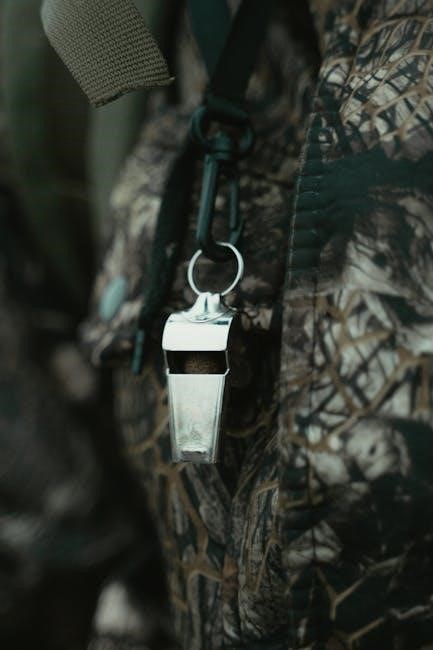Marksmanship Hunters excel in PvP as ranged DPS specialists‚ utilizing precision and versatility to dominate battlegrounds and arenas. Their strategic depth and high burst damage make them a formidable class.
1.1. Overview of the Marksmanship Hunter Spec
Marksmanship Hunters are a ranged DPS specialization that thrives on precision and high burst damage. They utilize abilities like Aimed Shot‚ Steady Shot‚ and Rapid Fire to deal consistent damage while maintaining mobility. The spec excels at kiting and controlling enemy movements‚ making it a versatile choice in PvP. With access to powerful defensive tools like Aspect of the Fox and Defensive Cooldowns‚ Marksmanship Hunters balance offense with survivability‚ making them a formidable opponent in both battlegrounds and arenas.
1.2. Strengths and Weaknesses in PvP
Marksmanship Hunters shine in PvP with exceptional burst damage and strong kiting capabilities‚ allowing them to control engagements effectively. Their ability to manage range and apply consistent pressure is a significant strength. However‚ they are vulnerable in close combat and rely heavily on defensive cooldowns. Limited CC options and susceptibility to melee classes can be challenging. Balancing mobility and damage output is crucial‚ making them a high-skill-cap spec that rewards strategy and precise play.

Optimal Talents for Marksmanship Hunter in PvP
Optimal talents for Marksmanship Hunters in PvP focus on enhancing burst damage‚ mobility‚ and survivability‚ ensuring versatility in competitive environments while maximizing effectiveness.
2.1. PvP Talents for Marksmanship Hunters
Key PvP talents for Marksmanship Hunters include Chimaeral Sting for crowd control‚ Consecutive Concussion to amplify burst damage‚ and Aspect of the Fox for enhanced mobility and focus generation. These talents are crucial for maximizing effectiveness in competitive matches‚ allowing Hunters to control engagements and deliver devastating bursts of damage while maintaining positional advantage.
2.2. Essential Talent Builds for Different Scenarios
For arenas‚ focus on burst damage with talents like Consecutive Concussion and Chimaeral Sting. In battlegrounds‚ prioritize mobility and utility with Aspect of the Fox and Binding Shot. Against healers‚ opt for Thrill of the Hunt to amplify burst potential. For melee-heavy comps‚ Counter Shot and Perforate are crucial. Tailor your build to the scenario‚ ensuring optimal performance in any PvP setting.
Stat Priority for Marksmanship Hunters in PvP
Versatility and Haste are prioritized for Marksmanship Hunters in PvP‚ enhancing survivability and attack speed. Balance Crit and Mastery to maintain consistent damage output and burst potential.
3.1. Versatility and Haste as Primary Stats
Versatility and Haste are the primary stats for Marksmanship Hunters in PvP‚ as they enhance both damage output and survivability. Versatility increases damage dealt and reduces damage taken‚ making it a well-rounded choice. Haste boosts attack speed‚ enabling faster auto-shots and reduced cooldowns for abilities like Aimed Shot and Chimaeral Sting. Together‚ these stats improve overall efficiency and burst potential‚ allowing Hunters to adapt to dynamic PvP scenarios effectively while maintaining consistent pressure on targets.
3.2. How to Balance Crit and Mastery
Critical Strike and Mastery are secondary stats for Marksmanship Hunters‚ requiring a balanced approach. Crit increases the chance for powerful critical hits‚ amplifying burst damage‚ while Mastery enhances Master Marksman‚ boosting damage from shots and abilities. Aiming for a moderate balance ensures consistent damage without over-relying on crits. Typically‚ a ratio of 1:1 or slightly favoring Mastery is ideal‚ as it stabilizes damage output and supports both sustained and burst playstyles effectively in competitive PvP scenarios.

Gear and Enchantments for Competitive Matches
Optimizing gear with the right enchantments and gems is crucial for Marksmanship Hunters in PvP. Focus on high-ilvl weapons‚ armor‚ and accessories to maximize damage output and survivability.
4.1. Best Gear Sets for Marksmanship Hunters
For competitive PvP‚ Marksmanship Hunters should focus on high-ilvl gear optimized for Versatility and Haste. Prioritize weapons with high damage per second and armor pieces with sockets for gems. Accessories like rings and necklaces should enhance Versatility and Haste to maximize damage output. Always enchant your gear with PvP-specific enchants to boost performance in battlegrounds and arenas. Ensure your set is well-rounded‚ balancing offensive stats with defensive capabilities for survivability.
4.2. Enchantments and Gems for PvP Optimization
Optimizing enchantments and gems is crucial for Marksmanship Hunters in PvP. Use Enchant Weapon ー Mark of the Thunderlord for consistent proc damage and burst potential. For armor‚ Enchant Chest ー Eternal Bounds boosts health‚ while Enchant Cloak ー Soulflow enhances mana regeneration. Gems should prioritize Versatility and Haste‚ with Versatile Shadowlands Gem and Quick Dawnstone being ideal choices. Socketing high-ilvl gear with these gems ensures maximum effectiveness in competitive matches.

Rotation and Burst Damage
Mastering the Marksmanship Hunter rotation involves balancing core abilities like Aimed Shot and Rapid Fire while setting up devastating bursts with Trueshot for maximum damage output in PvP scenarios.
5.1. Core Abilities and Rotation Basics
Marksmanship Hunters rely on Aimed Shot as their primary damage dealer‚ complemented by Rapid Fire for increased attack speed. Trueshot is a key cooldown that enhances damage output. The rotation revolves around maximizing Aimed Shot usage while maintaining Focus generation through Steady Shot. Proper timing of Chimaeral Sting and Consecutive Concussion ensures consistent pressure. Managing cooldowns like Aspect of the Fox is crucial for sustained mobility and damage in dynamic PvP scenarios‚ making the rotation both efficient and adaptable to various situations.
5.2. Setting Up and Executing Burst Damage
Burst damage for Marksmanship Hunters is centered around Trueshot‚ which significantly boosts attack power. Hunters should pre-cast Rapid Fire and ensure high Focus before triggering Trueshot. Pairing this with Aimed Shot and Chimaeral Sting amplifies burst potential. Coordinating with teammates to lock down targets ensures maximum impact. Proper setup and execution of this burst combo can quickly turn the tide in PvP encounters‚ making it a critical component of a Hunter’s offensive strategy.
Playstyle Tips for Marksmanship Hunters
Mastering Marksmanship Hunter PvP requires adaptability and precision. Focus on positioning‚ kiting‚ and managing cooldowns to maximize damage while staying out of harm’s way effectively in combat situations.
6.1. Managing Range and Positioning
Mastering range and positioning is crucial for Marksmanship Hunters in PvP. Always maintain a safe distance to avoid melee attacks‚ using abilities like Aspect of the Fox to stay mobile. Position yourself to maximize damage output while keeping enemies within your optimal range. Be mindful of your surroundings to avoid getting trapped or caught in enemy CC. Proper positioning also allows for effective kiting‚ ensuring you can harass opponents without taking unnecessary damage. This balance is key to dominating in both arena and battleground settings.
6.2. Kiting and Avoiding Enemy CC
Kiting is a fundamental skill for Marksmanship Hunters‚ allowing them to stay out of melee range while dealing damage. Use abilities like Disengage and Aspect of the Fox to maintain distance. Always anticipate enemy movements and be prepared to reposition quickly. Avoiding enemy CC is equally crucial; use defensive cooldowns like Aspect of the Turtle or Exhilaration to mitigate lockdown. Keep a safe distance and stay mobile to minimize the impact of stuns or roots‚ ensuring you remain a consistent threat in PvP encounters.
Cooldown Management
Marksmanship Hunters rely on strategic cooldown management to amplify damage and survive. Abilities like Aspect of the Fox and Chimaeral Sting are crucial for controlling enemy movements‚ while defensive cooldowns ensure longevity in intense PvP scenarios.
7.1. Aspect of the Fox and Chimaeral Sting Usage
Aspect of the Fox enhances mobility and focus regeneration‚ making it ideal for kiting enemies or repositioning during intense battles. Chimaeral Sting‚ a PvP talent‚ slows enemies by 30% and deals damage over time. Use it to control key targets‚ enabling your team to secure kills or prevent escapes. Proper timing of these abilities is essential for maximizing their effectiveness in both offensive and defensive scenarios.
7.2. Consecutive Concussion and Other Key Abilities
Consecutive Concussion is a powerful PvP talent that enhances Concussive Shot‚ increasing its slow effect and damage. Use it to control enemy movement and set up bursts. Pair it with Binding Shot for increased crowd control. Counter Shot interrupts and silences‚ disrupting healers or casters. These abilities synergize to create oppressive pressure‚ making it difficult for opponents to escape or react. Properly timing these tools is crucial for securing kills and dominating in arenas or battlegrounds.

Marksmanship Hunter in Different Expansions
Marksmanship Hunters have remained a viable PvP spec across expansions‚ with WotLK Classic emphasizing burst damage and Dragonflight focusing on mobility and utility‚ ensuring adaptability.
8.1. WotLK Classic Marksmanship Hunter PvP
In WotLK Classic‚ Marksmanship Hunters are highly effective in PvP due to their burst damage potential and mobility. The spec excels at kiteing and range management‚ utilizing abilities like Chimaeral Sting and Consecutive Concussion to control enemies. With proper play‚ they can dominate duels and battlegrounds‚ but their reliance on cooldowns makes consistency challenging. The key to success lies in mastering the rotation and defensive cooldowns like Aspect of the Fox‚ ensuring survival while dishing out high damage; This playstyle demands precise timing and positioning to thrive in competitive environments.
8.2. Dragonflight and The War Within Expansion Updates
Dragonflight and The War Within expansions revamped Marksmanship Hunters‚ enhancing their mobility and burst damage. New talents like Consecutive Concussion and Chimaeral Sting improve control and damage output. The spec now emphasizes versatility‚ with a focus on Haste and Versatility for optimal performance. These updates have solidified Marksmanship Hunters as a top-tier PvP spec‚ offering a balance of burst damage and survivability. Players can leverage these changes to excel in arenas and battlegrounds with refined rotations and strategic cooldown management.
Common Mistakes to Avoid
Common mistakes include overcommitting to fights‚ neglecting defensive cooldowns‚ and poor positioning. Avoid tunnel vision on damage without managing survivability and crowd control in PvP scenarios.
9.1. Overcommitting to Fights
Overcommitting is a common error‚ where Hunters stay too long in unfavorable situations. This often leads to being caught without defensive cooldowns or escape routes. Players must learn to disengage when outnumbered or low on health‚ preserving their position for better opportunities. Managing resources like Aspect of the Fox and Disengage is crucial to avoid unnecessary deaths and maintain pressure strategically in PvP encounters.
9.2. Not Utilizing Defensive Cooldowns
Failing to use defensive cooldowns is a critical mistake. Abilities like Aspect of the Turtle and Exhilaration can prevent unnecessary deaths. Hunters often neglect these tools during intense fights‚ leading to quick eliminations. Proper timing of these cooldowns can turn the tide‚ allowing escapes or buying time for healers. Always prioritize defensive cooldowns when health drops or enemy cooldowns are incoming to stay alive and maintain offensive pressure in PvP scenarios.
Marksmanship Hunters remain a powerful PvP spec‚ blending burst damage with strategic versatility. By mastering talents‚ stats‚ and cooldowns‚ players can excel in competitive environments and dominate matches.
10.1. Final Thoughts on Playing Marksmanship Hunter in PvP
Playing a Marksmanship Hunter in PvP is a rewarding experience‚ blending precision‚ adaptability‚ and high damage potential. Success hinges on mastering your rotation‚ managing cooldowns‚ and understanding enemy movements. While the spec offers a steep skill ceiling‚ consistent practice can elevate your gameplay. Embrace the challenges and enjoy the thrill of outperforming opponents with calculated bursts and clever positioning. Marksmanship Hunters remain a beloved and competitive choice for PvP enthusiasts in both classic and modern expansions.














































